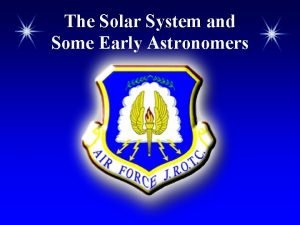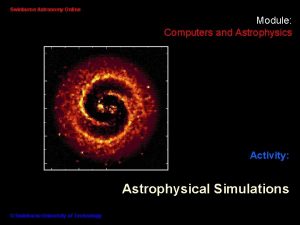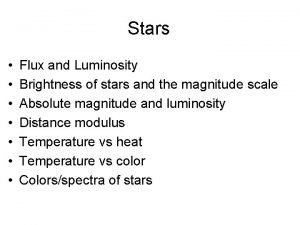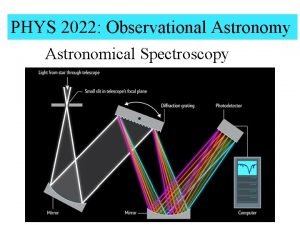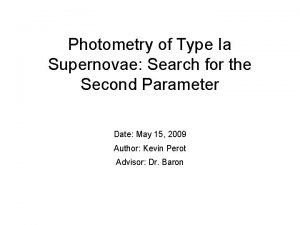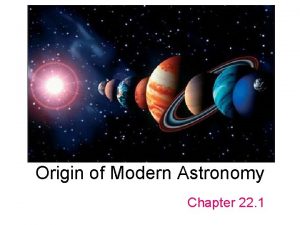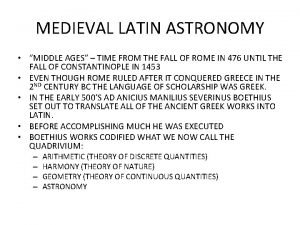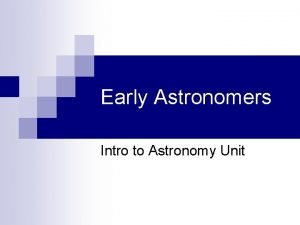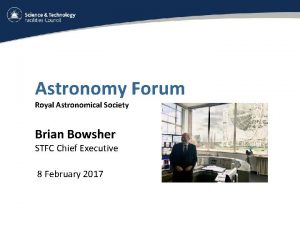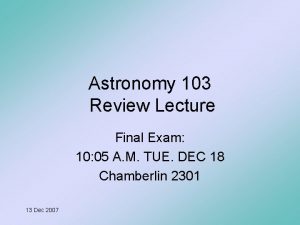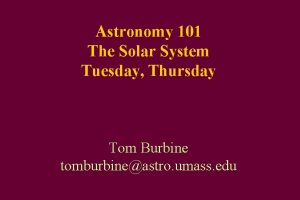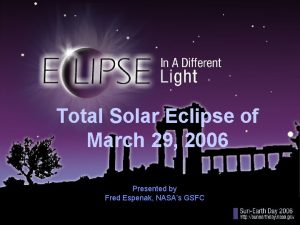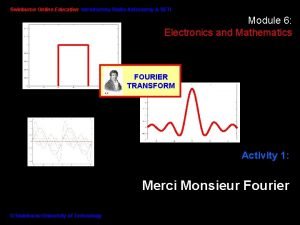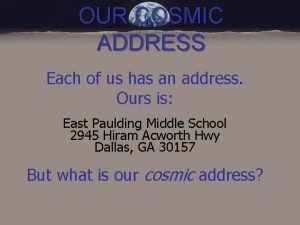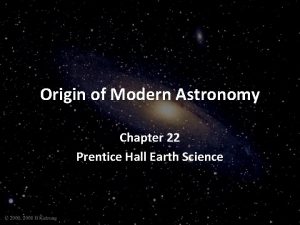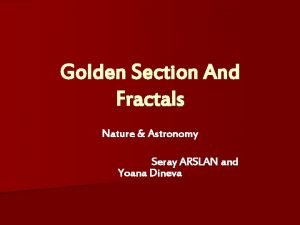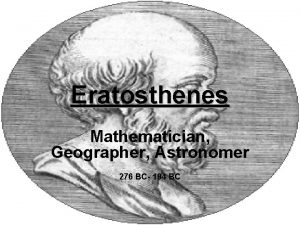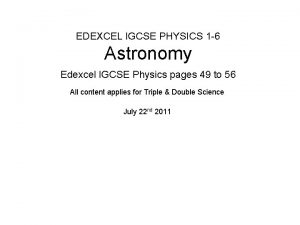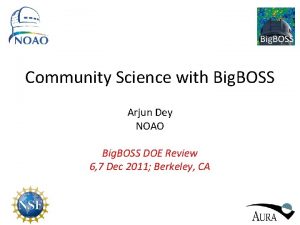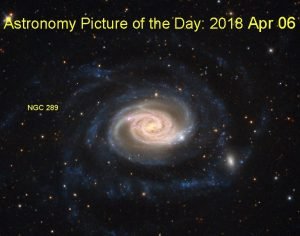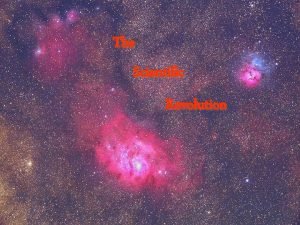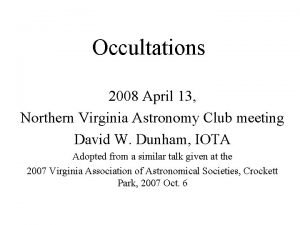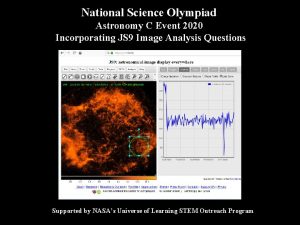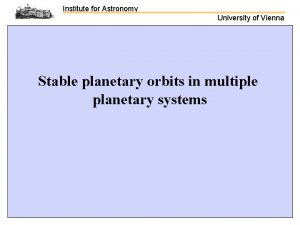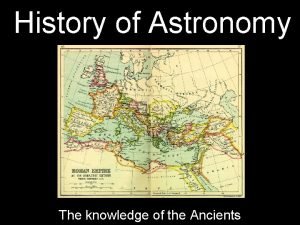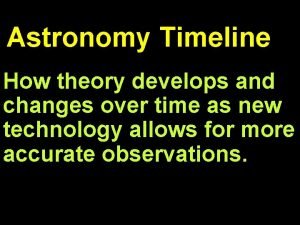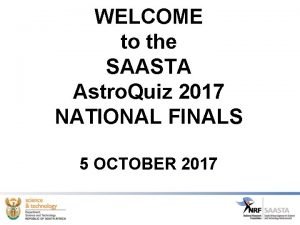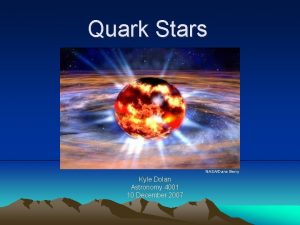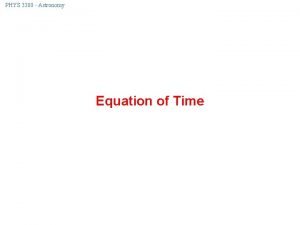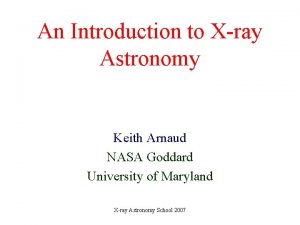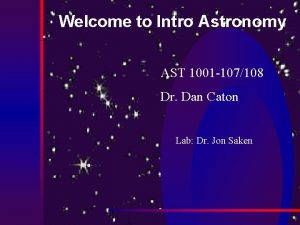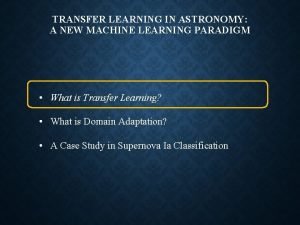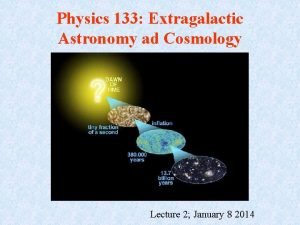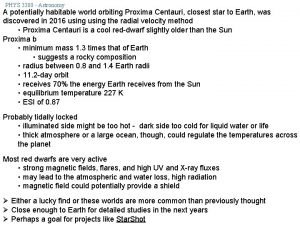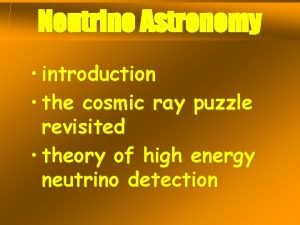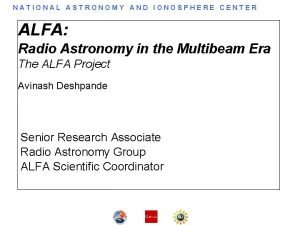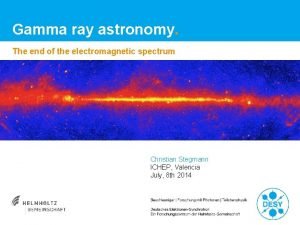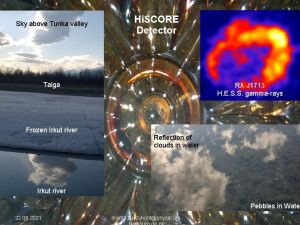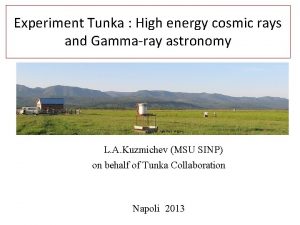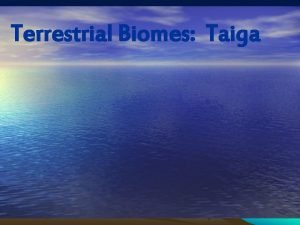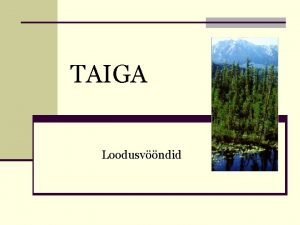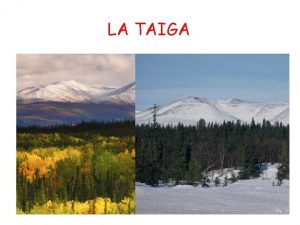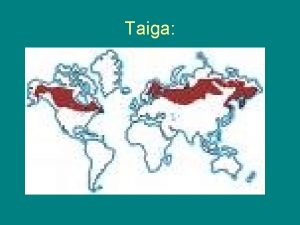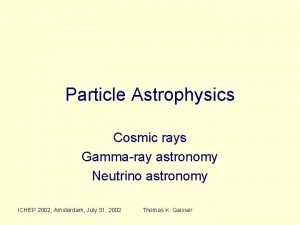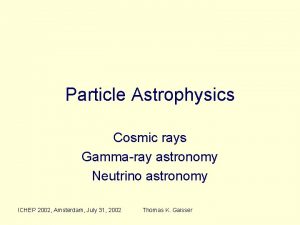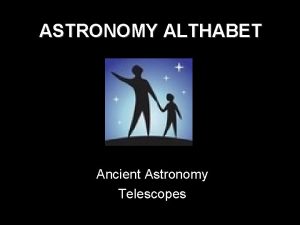TAIGA experimnent Ultrahigh energy gammaray astronomy at Tunka


































































- Slides: 66

TAIGA experimnent: Ultra-high energy gamma-ray astronomy at Tunka Valley Leonid Kuzmichev Skobeltsyn Institute of Nuclear Physics MSU July 2015, B. Koty Gamma-radiation > 0. 1 Me. V High energy gamma-ray astronomy > 1 Ge. V Very high energy gamma-ray astronomy (VHE)> 100 Ge. V Ultra high ebergy gamma-ray astronomy (UHE) > 10 Тe. V

2 lectures 1. High-energy gamma-ray astronomy - introduction 2. Gamma-ray observatory TAIGA «Physics» of gammaа-ray astronomy 1. Origin of Cosmic rays 2. Intrinsic structure of astrophysical objects 2 Gamma-astronomy and cosmology 3. Dark matter

Lecture 1: High energy gamma-ray astronomy

Plan 1. Introductions – aims of gamma-rays astronomy 2. Gamma-rays generation Synchrotron radiation Inverse Compton scattering Pi-0 decay 3. Absorption of gamma-rays 4. Gamma-rays and Super Nova Remnants (SNR) 5. Status of arrays and projects

How we study Universe OK 1 Te. V = 1012 e. V 1 Pe. V = 1015 e. V 1 Ee. V = 1018 e. V 1 Ze. V = 1021 e. V

Gamma-ray astronomy very successful part of astrophysics 150 Te. V sources 2000 Ge. V sources Instruments operation: 1. VERITAS 2. HESS 3. MAGIC 4. Fermi-Lat 5. Argo-Yb. J 6. Tibet-III 7. HAWC Projects: 1. CTA - 2017 -18 ? 2. LHAASO - 2017 -2018( ? ) 3. TAIGA

Te. V Pe. V hi

More than 100 local sources of gamma rays with energy >100 Ge. V

For this energy range (> 30 Te. V) (1 -10 )km 2 area arrays are needed

Galactic gamma-rays sources

2. Gamma-rays generation 1. Synchrotron radiation 2. Inverse Compton scattering 3. Pi-0 decay

Synchrotron radiation ν Larmor = 2. 8 106 ( B/ 1 G) Гц νсинх. = 3/2 ν Larmor ( E / m c 2 )3 - X-rays Intensity ~ B 2 flux of electrons

Inverse Compton –effect on relict photons Cross sections: σ = σthom. σтhom= 0. 66 10 -25 cm 2 ( S < (mc 2)2 ) σ = σthom (mc 2)2 / s ( S > (mc 2)2 εγ ~10 -4 -10 -3 э. В Eγ ~ εγ х ( E / mc 2 )2 100 Тe. V electron 20 Тe. V photons

Relation between fluxes and energy Photon from Inverse Compton -effect E γ = 2 ( εx / 0. 1 ke. V) (B/10 µG)-1 Synchrotron radiation 1 erg ~ 1 Te. V Flux of energy: f (E) = E 2 d. N/d. E ( erg/cm 2 sec) (f (Eγ)) inverse Compton f(εx) synchrotron = 0. 1 (B/10 µG)-2

Gamma-rays from pi- decay P + P π0 + All 2 γ E γ ~ 0. 1 E p Energy spectrum of protons : A E –γ Energy spectrum of gamma-rays : В E- γ why?

Synchroyton radiation Inverse Compton d. Ne / d. E ~ E –α d. Nγ /d. E ~ E-(α+1)/2

Gamma ray from protons d. N/d. E ~ E-p - pi-0 - gamma-rays d. N/d. E ~ E -p From electrons d. N/d. E ~ E-p - gamma-rays d. N/d. E ~ E –(p+1). 2

Absorption of gamma-rays γ + photon → e+ + e- λ (Mpc) University Galaxy Exp ( - l / λ) proton 1 Пэв 8 kpc 40 kpc

Distance from the nearest galaxies LMC - 160 kpc SNR 1987 Androdema 2 Mpc M 82 ( startburst galaxy) 4 Mpc Markarian 421 120 Mpc ( the nearest Blazar)

3. Gamma-astronomy and supernova remnants

SNRs – main sourses of Galactic Cosmic rays 1. 1933 – Baade and Zwicky– Explosion of SN – source of CR 2. 1949 – Fermi – first theory of cosmic rays acceleration Cas A 3. 1963 – Ginzburg, Sirovatsky – transfer of 10% of kinetic energy of SNR КЛ is enough to explain intensity of CR radio polarization in red (VLA), X-rays in green (CHANDRA), optical in blue (HST) SN explosion – 1053 erg Kinetic energy of - 1051 erg Rate- 1 per 30 y 4. 1977 – 1978 -Krymsky, Bell at all – theory of acceleration on shock waves 5. 1993 -1996 – Berezhko et al. – nonlineraly theory acceleration. 6. 2003 -2005 – Bell, Berezhko & Volk, Ptuskin & Zirakoshvily – amplification of magnetic field on the front of shock waves – Emax ~ Z · 1015 e. V

Observations nonthermal X-rays radio emission νMHz = 4. 6 BμG (Ee, Ge. V )2 E = 50 Me. V – 30 Ge. V (100 Ge. V for IR) γ = 1. 9 – 2. 5 We = 1048 – 1049 erg Ginzburg & Syrovatskii 1964 Shklovsky 1976 synchrotron γ e SNR π0 γ εke. V = 1 BμG(Ee/120 Te. V)2 εmax ~ 100 Te. V p e Compton γ inverse ε = ε (E /m c 2)2 γ 0 e e Te. V γ – rays electrons/protons εmax ~ 100 Te. V

Cosmic Ray diffusive acceleration in Supernova Remnants ESN ~ 1051 erg Krymsky 1977 Bell 1978 - is the shockcompression ratio =hock ratio for strong shock Frequent scatterings of CRs on magnetic field irregularities in collisionless medium provide efficient acceleration of CRs at strong shock

Maximum Energy Emax = U x R x B - Hillas rule Amplification of magnetic field By stream instability

Magnetic field amplification –steaming instability ρISM Beff Results of modeling (Lucek & Bell, 2000) & theoretical considerations (Bell 2004; Pelletier et al. 2006; Zirakashvili et al. 2007)+ VS BISM Spectral properties of SNR synchrotron emission + Fine structure of nonthermal X-ray emission CR flux shock SNR magnetic field is considerably amplified L 2 -2 Beff /8π ≈ 10 ρISMVS Beff >> BISM 2 B ~ 200 n 1/2 ( U/ 104 km/s ) 3/2 µG Emax ~ 200 n 1/2 ( U/ 104 km/s ) 2 Rpc Te. V

Filamentary structure of X-ray emission of young SNRs -consequence of strongly amplified magnetic field, leading to strong synchrotron losses Chandra Cassiopeia A Chandra SN 1006

Dependence of Emax from time Emax ~ U R B ~ U 2 R R = R 0 ( t/t 0) 2/5 Sedov solution t 0 – beginning of Sedov phase t 0 ~ n -1/3 M 5/6 E 1/2 - 100 -1000 years Emax ~ t -4/5


«Cooling» of electrons T 1/2 - time of transfer energy from eletrons to gamma-rays d. E/dt = b E 2 W CMB = 0. 25 e. V/cm 3 b = 4/3 (σT c )/ (mc 2 )2 ( W CMB + B 2/ 8π ) E (t ) = Eo/ ( 1 +bt E 0) Hight-energy gamma-rays σT h = 6. 6 10 -25 cm 2 Sychrotron radiation T 1/2 = 1/b. E 0 For E 0 =20 Te. V T = 5 10 4 y W CMB / W B = 0. 1 (B/10 µG )-2

«Cooling» of protons : Ƭpp = 1/ ( ngas · c · k - inelasticity σpp) = 6 x 107 ( n gas / 1 cm-3)-1 год,

Relation between fluxes of-gammarays Fγ ( IC) = W e / T F γ (π ) = Wp /Ƭ Fγ ( IC) / F γ (π ) = 10 3 ( We/ Wp) (n/1 cm-3)-1 for Eγ =1 Te. V

Derivation of DAV formula : Ƭpp = 1/ ( ngas · c · k - inelasticity σpp) = 6 x 107 ( n gas / 1 cm-3) год, P (E) = I x E-2 total energy = integral from 1 Ge. V to 1 Pe. V I x ln( 10^6) = 1050 erg I = 7 x 10^48 erg c (P -γ) = 0. 1 - part of proton energy transfered to gamma-ray Fγ (Eγ ) E ^2 = I x c (P -γ) / (Ƭpp ( 4π d^2) ) = 10^(-11) ( Wcr/ 10^50 erg) ( ( d/ 1 kpc)^-2 erg / cm 2 s n gas / 1 cm-3 )

SNR detected at Te. V energies Name RX J 1713. 7 Dist(kpc) 1 Size, pc Age, y 17. 4 L/ 1033 erg/c 1600 8 Ѓ (slope) 2. 0 RX J 0852 Vela Junor 0. 2 (1) 6. 8(34) 400(5000) 0. 26(6. 40) 2. 2 RCW 86 1(2. 50) 11(28) 1600(10000) 1(6) 2. 5 SN 1006 2. 2 18. 3 1000 1. 24 2. 3 Cas A 3. 4 2. 5 350 7 2. 4 Tycho 1572 3. 5 6 443 0. 1 1. 95 SNR G 353. 6 -07 3. 2 27 2500 (14000) 10 2. 3




Molecular clouds : possibility to catch Pe. Vatrons If clouds is in a distance of 100 pc from SNR flux will be in 10 times smaller, but duration Will be in 20 time longer – near to 10000 y/ Mass (104 - 105 ) M of Sun Density ~100 g/ cm 2 1% of Galaxy volume mostly from H 2

Gamma-ray astronomy and Crab nebular Explosion in 1054 , distance 2 kp, In the centre of nebular –pulsar with 33 ms period First reliably registrated gamma-ray source T. Weeks 1989. 9 RMS 1. Steady gamma-radiation – standard candle 2. “pulsate” gamma-radiation 3. Gamma «bursts»

Inserlude: extensive atmospheric showers (EAS)

P, A increasing number of particles 20 -30 km Хmax = A + B Ln( E/A) Nmax 3 -5 км Shower particles Xmax – maximum of EAS develompent number of particles E Atomic number Energy Half of the particle in the circle of 80 m Shower core Energy of particles: Electrons: 30 -100 Me. V Particle detectors Muons 0. 5 Gev

P, A Registration of Chrenkov light for Ee >25 Me. V Ve > C/ n the air – speed of light in Cos (tet) =1/n 20 -30 km tet ~0. 5 deg Cherenkov light Q tot E Phonons detectors

Energy threshold of Cherenkov array Cherenkov pulse T signal noise = Sd– area of PMT QE- quantum efficiency Ss • Pph • QE • Sд • Iф • T Pph ~ E - energy of EAS Ethersh ~ Iф • • T 5 Pph– поток черенковских фотонов T - duration of pulse ( 10 - 20 ns) - FOV Iф – night light background Sд • Sd ~ 0. 1 m 2 и QE 0. 1 : Eth 200 Тe. V 3. 1012 m-2 sec 1

How select gamma-shower from proton shower Signal = (background )1. 2 F( gamma) x S x T = 5 (F(CR)x S x Ω x T)1/2 Background selection : Imaging atmospheric Cherenkov telescope poor muons showers ( in gamma showers in 30 times smaller muons than in proton shower) Q = K signal / sqrt ( K background) K signal, Kback –rejection factors.

Short history of gamma-rays astronomy

Cherenkov Technique used for Gamma Ray Astronomy Crimea Experiment 1959 -1965, Chudakov, et al. , (SNR, radio galaxies)

First Gamma-ray Experiment at Whipple Observatory, 1967 -68 The pioneer, the #1 in gamma astronomy 56

The Pioneer Trevor Weekes and his 10 m Ø Whipple telescope gave birth to g-ray astrophysics: 9 s from Crab Nebula in 1988 ! „If a telescope can within a few s evaporate a solid piece of steel, it can also measure gamma rays“ ; -) 57

Instruments





Number of muons in proton EAS in 30 times more than in gamma-EAS

HAWC (High Altitude Water Cherenkov) Te. V Gamma-Ray Observatory

HAWC Site Location in Mexico • 4100 m (13, 500’) above sea level • Latitude of 19 deg N • Temperate Climate • Existing Infrastructure HAWC Large Millimeter Telescope (50 m dia. dish) Pico de Orizaba 5600 m (18, 500’)







NEW projects

An observatory for ground based gamma-ray astronomy: CTA 3 types of mirrors: 24 m diameter , FOV 4 -5 deg 10 m , FOV 6 -8 deg ( 100 Ge. V – 10 Te. V) 4 -6 m FOV 10 deg > 10 Тe. V

LHAASO——The third generation of survey facility for VHE γray sources 24 Wide FOV air Cherenkov image Telescopes. For Air Fluorescence measurement above 0. 1 Ee. V also 400 burst detectors For high energy Secondary particles Near the core of air showers 6100 scintillator detectors and 1200 μdetector s form an array covering 1 km 2 LHAASO Layout in 1 km 2 at 4300 m a. s. l. 90 k square meter Water Cherenkov Deter array. Each one has a size of HAWC

Survey for γ-sources very detailed spectroscopy investigation ( a few hundred extra-galactic sources are expected ) 1000 10 Ev/yr

Thank you
 Tunka manin accomplishments
Tunka manin accomplishments Ka tik pamato pats tuo pavirsta
Ka tik pamato pats tuo pavirsta Learning astronomy by doing astronomy activity 1 answers
Learning astronomy by doing astronomy activity 1 answers Learning astronomy by doing astronomy activity 1 answers
Learning astronomy by doing astronomy activity 1 answers Learning astronomy by doing astronomy
Learning astronomy by doing astronomy Energy energy transfer and general energy analysis
Energy energy transfer and general energy analysis Energy energy transfer and general energy analysis
Energy energy transfer and general energy analysis What is astronomy
What is astronomy Claudius ptolemy astronomy contributions
Claudius ptolemy astronomy contributions Astronomy greek roots
Astronomy greek roots Swinburne astronomy online
Swinburne astronomy online Mizar luminosity
Mizar luminosity Luminosity to magnitude
Luminosity to magnitude Clea exercises
Clea exercises Astronomy questions and answers multiple choice
Astronomy questions and answers multiple choice Phys 2022
Phys 2022 Distance ladder astronomy
Distance ladder astronomy Origin of modern astronomy chapter 22
Origin of modern astronomy chapter 22 Astronomy in the middle ages
Astronomy in the middle ages Astronomy definition earth science
Astronomy definition earth science Claudius ptolemy astronomy contributions
Claudius ptolemy astronomy contributions Cuhk astronomy
Cuhk astronomy Astronomer vs astrologer
Astronomer vs astrologer Astronomy forum uk
Astronomy forum uk Astronomy 103 final exam
Astronomy 103 final exam Astronomy 101 formulas
Astronomy 101 formulas Astronomy science fair projects
Astronomy science fair projects Astronomy picture of the day march 29 2006
Astronomy picture of the day march 29 2006 Time domain astronomy
Time domain astronomy Ruth bruno
Ruth bruno Our cosmic address is
Our cosmic address is Chapter 22.2 origin of modern astronomy answer key
Chapter 22.2 origin of modern astronomy answer key Astronmo
Astronmo Radio astronomy lectures
Radio astronomy lectures Astronomy picture of the day
Astronomy picture of the day Time domain astronomy
Time domain astronomy Golden ratio in astronomy
Golden ratio in astronomy Naap astronomy
Naap astronomy 276 bc
276 bc Astronomy igcse
Astronomy igcse Michigan state university physics department
Michigan state university physics department Time domain astronomy
Time domain astronomy Astronomy picture of the day 17 april 2001
Astronomy picture of the day 17 april 2001 Astronomy 161
Astronomy 161 Tycho brahe astronomy
Tycho brahe astronomy Northern virginia astronomy club
Northern virginia astronomy club Science olympiad astronomy
Science olympiad astronomy Astronomy
Astronomy Astronomy in ancient rome
Astronomy in ancient rome Astronomy timeline project
Astronomy timeline project High point astronomy
High point astronomy Saasta astro quiz 2017 round 2 questions and answers
Saasta astro quiz 2017 round 2 questions and answers Saasta astro quiz 2019 round 2 answers
Saasta astro quiz 2019 round 2 answers Ebit
Ebit Quark astronomy
Quark astronomy Astronomy
Astronomy 3 classification of science
3 classification of science Astronomy careers nz
Astronomy careers nz Astronomy
Astronomy Ast 1001
Ast 1001 Machine learning in astronomy
Machine learning in astronomy V zc astronomy
V zc astronomy Astronomy
Astronomy Astronomy
Astronomy Ionosphere
Ionosphere Astronomy
Astronomy Astronomy
Astronomy








